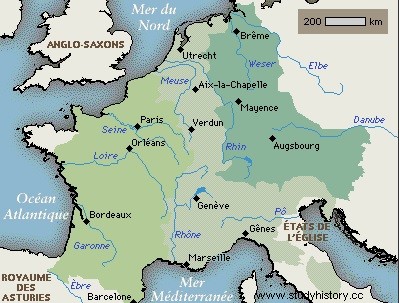 The Treaty of Verdun of 843 put an end to the conflict between the three sons of Louis I the Pious for the possession of the Frankish Empire built by their grandfather Charlemagne. According to the terms of this agreement, the Empire was divided into three parts, effectively putting an end to the brief unification of Western Europe:Charles the Bald received the territories in the west of present-day France, Louis the German the Germania and, between the two kingdoms, Lothair founded Lotharingia (Alsace, Lorraine, the Netherlands, Burgundy and northern Italy). From this partition will be born the kingdom of France in the west and the Holy Roman Empire in the east.
The Treaty of Verdun of 843 put an end to the conflict between the three sons of Louis I the Pious for the possession of the Frankish Empire built by their grandfather Charlemagne. According to the terms of this agreement, the Empire was divided into three parts, effectively putting an end to the brief unification of Western Europe:Charles the Bald received the territories in the west of present-day France, Louis the German the Germania and, between the two kingdoms, Lothair founded Lotharingia (Alsace, Lorraine, the Netherlands, Burgundy and northern Italy). From this partition will be born the kingdom of France in the west and the Holy Roman Empire in the east.
The Battle of Fontenoy-en Puisaye
Louis I, known as "le Pieux" or "le Débonnaire", born in 778, sixth child and fourth son of Charlemagne, died on June 20, 840 in Ingelheim. He leaves the empire to his three surviving children 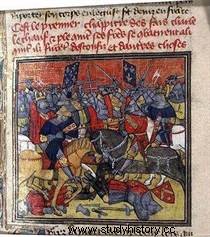 Lothaire (born in 795) and Louis (born in 806), from his first marriage with Ermengarde as well as Charles, born in 823, from his second marriage to Judith of Bavaria. Pepin, his second son born in 797, died in 838. As soon as his father's death was announced, in defiance of the last partition agreement concluded in 839, Lothair returned from Italy and tried to enforce the Ordinatio Imperii of 817, by which he was sole heir to the entire empire, his two brothers inheriting their own kingdoms included in the empire, respectively Bavaria and Aquitaine, but remaining subordinate to their elder brother. They must visit it every year bringing it gifts. Furthermore, they cannot marry and go to war without their brother's approval.
Lothaire (born in 795) and Louis (born in 806), from his first marriage with Ermengarde as well as Charles, born in 823, from his second marriage to Judith of Bavaria. Pepin, his second son born in 797, died in 838. As soon as his father's death was announced, in defiance of the last partition agreement concluded in 839, Lothair returned from Italy and tried to enforce the Ordinatio Imperii of 817, by which he was sole heir to the entire empire, his two brothers inheriting their own kingdoms included in the empire, respectively Bavaria and Aquitaine, but remaining subordinate to their elder brother. They must visit it every year bringing it gifts. Furthermore, they cannot marry and go to war without their brother's approval.
Therefore, the conflict between the three brothers is inevitable. Each raises an army and gathers his followers around him. The most fragile position is that of Charles who inherited Aquitaine where he resides with his mother Judith, but there he must fight against the supporters of his nephew Pépin II, ousted at the death of his father Pépin I. Louis , meanwhile, is well established in Bavaria. Lothair has the strongest position. The financial means at his disposal combined with intimidation maneuvers enabled him to rally to his cause several Greats of the kingdom such as Hilduin, the Abbot of Saint-Denis or Girard, Count of Paris. In addition, to weaken his brothers, he supports the rebellions which smolder in their kingdom, on the one hand the Saxons against Louis and on the other hand the Aquitanians against Charles.
No doubt at the instigation of Judith, the two brothers Charles and Louis get closer and join their armed forces. The confrontation against Lothaire took place on June 25, 841, at Fontenoy-en-Puisaye, near Auxerre. At the end of a deadly fight, a real carnage according to contemporaries - 40,000 dead including many nobles such as Gérard, Count of Auvergne, and Ricuin, Count of Nantes - Lothaire's army was routed and took the escape.
In 1860, the Second Empire erected an obelisk on a hill overlooking the village of Fontenoy-en-Puisaye, to commemorate the battle considered the prelude to the partition of Verdun and to the construction of the Germanic and French nations.
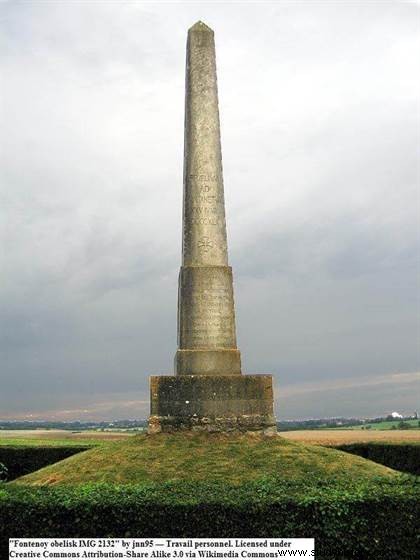 It reads:
It reads:
The Strasbourg oaths
The two brothers then present the outcome of the battle of Fontenoy-en-Puisaye as the result of the Judgment of God. Several large, remained in expectation, join their party. Thus, Bernard of Septimania entrusts his son Guillaume, aged 16, to Charles the Bald and, on the occasion of his departure, his mother Dhuoda writes an education treatise entitled "Manual for my son" which is now one of the masterpieces of the literature of that time:But Lothaire, who took refuge in Aix, did not capitulate and he still intends to follow the provisions laid down by the Ordinatio Imperii.
Under these conditions, Louis and Charles decide to further strengthen their alliance. On February 14, 842, during an assembly held in Strasbourg, they took an oath by which they mutually agreed to help each other and not to deal separately with Lothair. Their men, meanwhile, undertake to abandon their lord if he breaks his word.
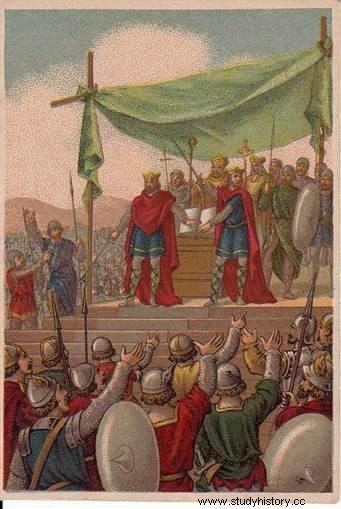 The texts of the oaths have come down to us, reported by the chronicler and lay abbot of Saint-Riquier Nithard (800, †859), grandson of Charlemagne, conceived out of wedlock by his daughter Berthe by the poet Angilbert. Ally of Charles the Bald, Nithard wrote a chronicle in 4 volumes, "History of the Sons of Louis the Pious" which relates in particular the adventures of the fight between the three brothers.
The texts of the oaths have come down to us, reported by the chronicler and lay abbot of Saint-Riquier Nithard (800, †859), grandson of Charlemagne, conceived out of wedlock by his daughter Berthe by the poet Angilbert. Ally of Charles the Bald, Nithard wrote a chronicle in 4 volumes, "History of the Sons of Louis the Pious" which relates in particular the adventures of the fight between the three brothers.
The texts of the oaths reported by Nithard in his chronicle represent the oldest texts available to us in the "vulgar" language, the Romance language (Old French) and the tudesque language (High German). . Indeed, in order to be understood by all the soldiers assembled around them and who do not necessarily understand Latin, each brother pronounces his oath in the "vulgar" language of the other:thus Charles expresses himself in the tudesque in order to be heard by Louis's soldiers. Louis expresses himself in the Romance language in order to be understood by Charles's men. Then, in turn, the men of both take the oath, in their own language.
Oath of Louis the German in the Romance language, which swears first with regard to his birthright.
Oath of Charles the Bald in the tudesque language
Charles Men's Oath, in Romance language
The Treaty of Verdun (843)
At the end of the oaths of Strasbourg, the armies of Charles and Louis march on Aix-la-Chapelle, the two brothers having the will to depose their brother. Lothair flees, taking care to carry away the treasure. With the support of a large part of the episcopate which, during a council meeting in Aix, pronounced the dismissal of Lothair, they began to negotiate a division of the Empire between them, leaving Italy as the only part devolved to Lothair.
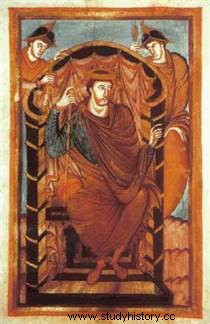 In April 842, Lothair made peace proposals and, in June, the three brothers met near Mâcon , on the Saône, in order to negotiate a tripartition of the Empire. It was therefore decided to divide the Empire into three parts, each brother keeping the kingdom that had long devolved to him, namely Aquitaine for Charles, Bavaria for Louis and Italy for Lothair. In order to be able to share the rest of the territory equitably, several missi were appointed, with the task of drawing up an inventory of tax assets, abbeys, bishoprics, counties, etc. using previous maps, inventories and sharing projects.
In April 842, Lothair made peace proposals and, in June, the three brothers met near Mâcon , on the Saône, in order to negotiate a tripartition of the Empire. It was therefore decided to divide the Empire into three parts, each brother keeping the kingdom that had long devolved to him, namely Aquitaine for Charles, Bavaria for Louis and Italy for Lothair. In order to be able to share the rest of the territory equitably, several missi were appointed, with the task of drawing up an inventory of tax assets, abbeys, bishoprics, counties, etc. using previous maps, inventories and sharing projects.
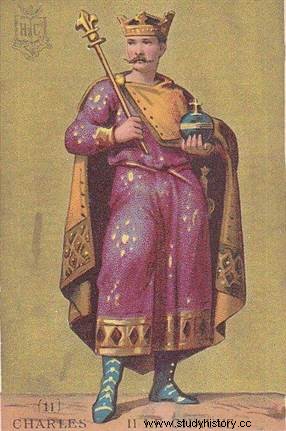 The negotiations lasted a year punctuated by several meetings. These take place on the Rhine, with Lothair's men camping on the opposite bank to that of Louis and Charles' men in order to avoid any quarrel. The situation of the empire is difficult. Empress Judith died on April 13, 843; the Saracens attack Italy and Provence; the Vikings increase their raids and notably loot the city of Nantes on June 24; the Breton Nominoë, in rebellion, defeated Count Renaud in charge of containing him. After a particularly harsh winter, famine raged; revolts break out.
The negotiations lasted a year punctuated by several meetings. These take place on the Rhine, with Lothair's men camping on the opposite bank to that of Louis and Charles' men in order to avoid any quarrel. The situation of the empire is difficult. Empress Judith died on April 13, 843; the Saracens attack Italy and Provence; the Vikings increase their raids and notably loot the city of Nantes on June 24; the Breton Nominoë, in rebellion, defeated Count Renaud in charge of containing him. After a particularly harsh winter, famine raged; revolts break out.
The talks accelerated and, finally, in August 843, a partition agreement was reached known as the "Treaty or Partition of Verdun". This agreement was consecrated in Verdun Cathedral by Bishop Hilduin (824-847), a close friend of Louis the Pious. Each kingdom is territorially continuous and its king has full sovereignty. None of the three brothers has more prerogatives than another.
• Louis receives the eastern part of the Empire, East Francia:Bavaria, the provinces of Alemania and Franconia as well as Saxony;
• Charles receives the lands located west of the Scheldt-Meuse-Saône-Rhône line, namely West Francia, Aquitaine, Septimania;
• Lothair receives a kingdom sandwiched between the two parts of his brothers, the Francie Médiane, which goes from Friesland to Provence including Lotharingia and Italy. He keeps the title of Emperor and his kingdom includes the two capitals of the Empire, the political capital Aix and the religious capital Rome.
Unfortunately, no official text of this treaty has reached us. The provisions are known to us through other writings, in particular the annals of Saint Bertin or the annals of Fulda.
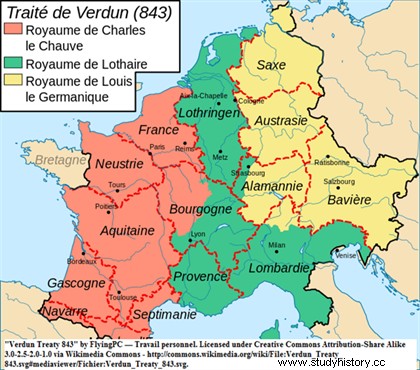 The distribution of land and the delineation of the resulting borders was essentially dictated by the need to include in each of the kingdoms the benefits of the great faithful of each of the brothers:a man being able to swear loyalty to only one of the three brothers, it was advisable to avoid that a “vassal” finds his lands spread over two distinct kingdoms. It was also appropriate that each of the brothers maintain in his kingdom the benefits of his greatest followers. Despite this, some nobles had to completely give up their lands and related honors to remain in loyalty to their chosen one. This is particularly the case of the counts of Worms, family of Robert le Fort, who left the Mainz region to settle on the Loire, passing into the service of Charles the Bald.
The distribution of land and the delineation of the resulting borders was essentially dictated by the need to include in each of the kingdoms the benefits of the great faithful of each of the brothers:a man being able to swear loyalty to only one of the three brothers, it was advisable to avoid that a “vassal” finds his lands spread over two distinct kingdoms. It was also appropriate that each of the brothers maintain in his kingdom the benefits of his greatest followers. Despite this, some nobles had to completely give up their lands and related honors to remain in loyalty to their chosen one. This is particularly the case of the counts of Worms, family of Robert le Fort, who left the Mainz region to settle on the Loire, passing into the service of Charles the Bald.
The consequences of the Treaty of Verdun
The clauses of the Treaty of Verdun permanently fixed the borders of Medieval Europe, in particular those established between the kingdom of Charles and the kingdom of Lothair. Throughout the Middle Ages, the Scheldt and the Rhône separated “France” from the lands of the Empire. The Saône cuts Burgundy into two parts, to the west the duchy, to the east the county. Even if the borders between the kingdom of Lothair and that of Louis remain less stable, they also draw the shape of the future Germania.
For contemporaries, the treaty marks the end of a dream, that of preserving the unity of the Empire of Charlemagne. Thus, the cleric Florus of Lyon expresses his bitterness in a poem entitled "Querela de divisione Imperii" in these terms:
Bibliography
• Pierre Riché, The Carolingians, a family that made Europe, Pluriel 2012.
• Pierre Ripert, The shattered empire of Charlemagne, the time of the swords, Editions Privat 2002.
• Christian Bonnet, Christine Descatoire, The Carolingians (741 – 987), Armand Colin 2001.
• Geneviève Bührer-Thierry, Charles Mériaux, 481-888, France before France, Belin 2010.
